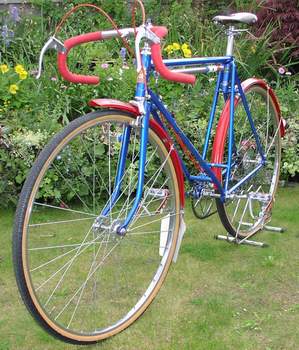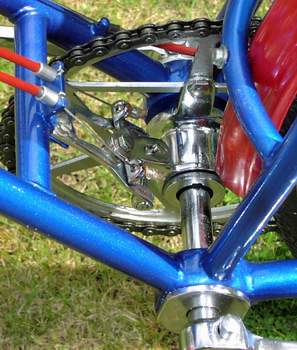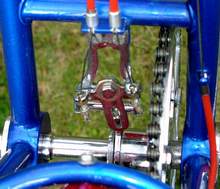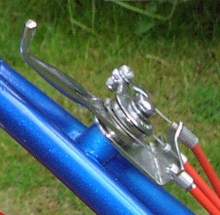Elswick-Hopper
Posted: Tuesday 02nd June 2020
(Although Elswick-Hopper did not make one-off frames for the general public, the Covincible is such a rare collector’s item that it has been included amongst Classic Builders – Peter Underwood)
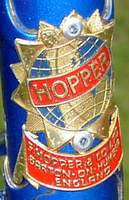
The Elswick-Hopper Convincable was based on the ideas of Hull man Ben Oldridge. Ben started his working life as an apprentice at the Elswick-Hopper Cycle Works at Barton-on-Humber in North Lincolnshire. His family soon moved across the river to Hull and eventually Ben went into business with a Mr Barry, repairing cars, motorcycles, cycles and radios. Early in WW2 the building was demolished by a direct hit from a land mine and although Ben tried to secure what was left of his tools and stock everything had disappeared by the next morning. This distressed him more that the loss of the business and with no premises and no tools Ben was assigned to munitions work and sent to Lincoln to work at the Avro factory, repairing Lancaster bombers. After release from this assignment he found new premises just across the road from his old shop. Ben’s interest was turning towards new ideas on bicycle design and his skills were such that his ideas were quickly transformed into real machines. It is believed that he built five prototypes, including the one in the Museum of Street Life in Hull upon which the Convincable is clearly based. In 1947 he applied for a patent on his ideas and was finally granted patent 640683 in 1950.
Ben’s patent was primarily concerned with the riding position of a racing cyclist, ensuring that the rider was as close as possible to being vertically over the pedals and the rear wheel. This entailed a design with a very short wheelbase, and the consequent problems of chain alignment. He also had ideas on a back pedalling brake, a gearbox within the bottom bracket, and a shaft drive. The answer to all these problems was seen by Ben as a twin tube frame, with a longer than usual bottom bracket axle that could accommodate an inboard chain wheel which would move across so that it was always in alignment with the selected rear sprocket. Having obtained the patent, Ben offered it to Raleigh, who declined due to the cost of retooling for production, and to Elswick-Hopper who decided to build a bicycle based on the patent.
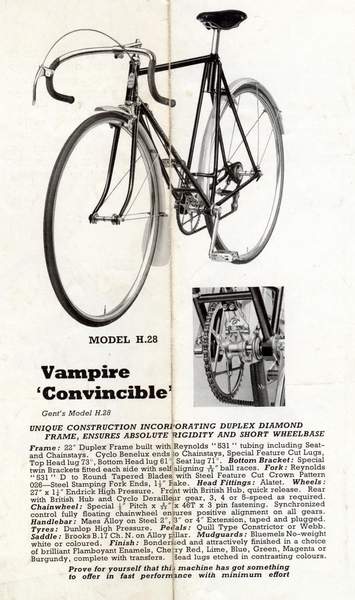
The new design was launched at the 1955 annual Cycle Show held at Earls Court, where Elswick-Hopper revealed what the cycling press of the time described as the sensation of the show. The catalogue describes it as having a duplex frame built with Reynolds 531 tubing, including seat and chain stays and forks. It had a 37½ inch wheelbase, considerably shorter than the 41 inch conventional model. There were two very similar cycles, the Hopper Vampire Convincible, and the Elswick Avenger Convincible. Unfortunately for Elswick-Hopper, by the time they produced their cycle, the alignment problem had already been resolved by the development of more flexible chains by the French and Italians. Cyclists obviously did not consider the extra weight that the design had incurred to be worthwhile and the project was a failure. It is not known how many were produced, but ex-Elswick-Hopper employees think it was six or less. The few models made were produced by highly skilled Tool Room mechanics and were totally hand made. The company records, stored in the Grimsby archives, show that in 1956 there were over 1,900 transfers still in stock, all of which had the spelling Convincable. It is also doubtful that Elswick-Hopper would ever have made money from the design. The 1956 price list shows the Convincable priced at £38 17s 5d, against £27 17s 5d for the next most expensive in their range. There is no other example known to exist, although mention has been made of others in Nottinghamshire and Edinburgh.
The machine shown is frame number 002 and it was given to Jack Tighe,who rode Hopper track bikes, to test them for the company. Jack was a top track racer from the late 40s to the mid 50s, and is still a very active supporter of the Scunthorpe Polytechnic Road Club. Gradually components were removed for other machines and the frame lay in his shed until his brother took it in to Falcon Cycles in Barton and handed it over to the then Managing Director, former International rider Ernie Clements. During the restoration of the bike a second set of head badge rivet holes were found, which indicate that at some time this frame had an Elswick head badge, which would be consistent with the original Avenger transfer. The fact that Jack rode Hopper track bikes may explain why this bike is now fitted with a Hopper head badge.
The bottom braket on the Convincable has special twin brackets mounted either side of the twin tube bottom bracket area and these are fitted with 3/16″ self-aligning ball races.
Posted: Tuesday 02nd June 2020
This article appears in the following categories.
Upcoming Events
Whether you are looking for a gentle social meet up, or a 100-mile ride browse the community’s upcoming events and plan your next weekend outing.

